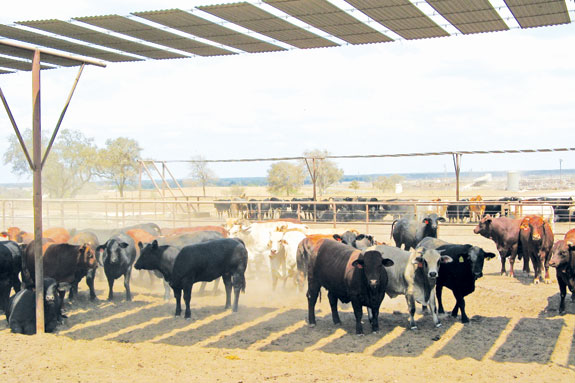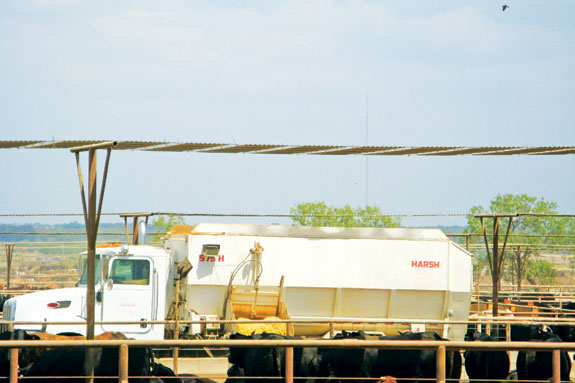The company is located four miles south of Gonzales, Texas, on Highway 183 and works hard at being a good neighbor to the city.
Whether in the backgrounding pastures or in the pens, cattle are well-fed, healthy and contented.
From mid-morning to late afternoon they lay in the shade and chew their cuds, making very little noise.
Graham Land and Cattle Co. personnel are very involved in community affairs and in the beef cattle industry.
Stroll through the offices and you’ll see framed photographs of company-sponsored Little League baseball.
On another wall hang framed newspaper clippings and other documents depicting achievements and recognitions of Charles W. Graham, DVM of Elgin, Texas. Graham co-owns the land and cattle company with his grandson, Tyler Graham.
“Dr. Graham is and has been a huge supporter of beef cattle research and education through the Texas A&M University Animal Science Department and Texas AgriLife Extension,” says Joe Paschal of Texas AgriLife Extension.
“He has supported educational programs in beef cattle at the county and state level and especially through the annual Texas A&M Beef Cattle Short Course.
“Dr. Graham also supports and is an active member of the American Breeds Coalition, which promotes the usefulness of beef cattle breeds with Brahman genetics (Brahman, Beefmaster, Braford, Red Brangus, Santa Gertrudis and Simbrah).”
You won’t hear Gonzales citizens complaining of smells or noises from the cattle feeding operation. Pens are cleaned frequently and the manure spread on pastures.

Soil samples are taken regularly and analyzed for nitrate, potassium and sulfur so that residual levels are kept under EPA guidelines and at amounts necessary for optimum forage growth.
The feeding pens are built on a well-drained site containing insoluble soils that promote runoff of water and other liquids into a catchment system.
Effluent is transported through the catchment system into an oxidation pond.
“Graham Land and Cattle Co. was an early supporter of the Texas A&M Ranch to Rail Program, which provided feeding, health, carcass and economic performance data to over 2,500 rancher entries of over 25,000 head of cattle,” Paschal adds.
“The feedyard has been home to the American Brahman Breeders Association’s Steer Feedout and Carcass program for over 10 years.
This program produced data on nearly 1,500 head of straightbred and crossbred Brahman steers that were used to create expected progeny differences (EPDs) for several carcass traits, including Warner Bratzler Shear Force Tenderness.
They have allowed several other breed associations, including Beefmaster and Red Brangus, to conduct research on feedyard performance.”
The original feedyard was built in 1964 by the Harrell brothers. Graham bought the feedyard from the Harrell Cattle Co. in 1987 and the business has been growing ever since.

Jay Gray, general manger of Graham Land and Cattle Co., gives his father credit for his early education in feeding cattle.
When the family had a cow-calf operation and during the ’60s they continually had approximately 200 calves in their feedlot.
While at Texas A&M earning degrees in agricultural economics and business, Gray spent his summers working in feedyards.
After graduating he went to work for the Harrell Cattle Co. and remained with the feedyard following its purchase by Graham. Gray has had his own cattle on feed continually since the late ’70s.
“My primary job is to ensure that the company and our custom feeder customers make a profit,” explains Gray.
“I believe in cattle cycles and repetitive history. This present cattle liquidation period began in 2006 with interruptions from wet periods in 2007 and 2010. Due to last year’s severe drought, herd liquidation resumed. I spend a lot of time studying historical weather patterns and market trends to help prepare for the next cattle population cycles.”
Gonzales is at the confluence of the Guadalupe and San Marcos rivers and their deltas are composed of rich soils.
The soils, plus a moderate climate, result in a good environment for growing both warm-season and cool-season forages for the land and cattle company’s backgrounding program.
Gonzales County ranks first in Texas in cow-calf production and adjoining Fayette County ranks a close second, resulting in a good calf supply.
The company is located in an area close to sources of their required inputs. They are within short hauling distances of the Texas Coastal Plain crop belt that runs from Corpus Christi to Houston and the Blackland Prairie that runs from Taylor to the Dallas-Fort Worth area.
Corn, which is the feedyard’s major feed ingredient, is raised in both of these areas. Other ration ingredients include wet brewers grain from Anheuser-Busch in Houston, rice bran from the Coastal Plain and cottonseed hulls from both crop areas.

Although the feedyard has access to both Panhandle and south Texas processors, most of their cattle are sold to Sam Kane in Corpus Christi because of less transportation costs and the good relationship between the two companies. Cattle are sold before they leave the feedyard.
“Graham Land and Cattle Co. is a service-oriented organization,” says Gray. “We provide feeding opportunities for small and large producers.
If you have one calf or 10,000, we will feed them for you. Several of our customers feed one calf at a time to stock their freezer and we have a client who feeds 3,500 to 4,000 head at a time.”
Approximately 30 percent of the cattle on feed at Graham Land and Cattle Company are under retained producer ownership and about 68 percent are investor-owned cattle.
Some investors buy their cattle and others ask that the feedyard do it for them. Only about 200 to 230 head of cattle on feed are company-owned.
“We are a licensed feedyard for the Nolan Ryan Tender Aged Beef (NRTAB) program and specialize in feeding Brahman-influenced cattle.
Consultation is offered to our suppliers to help them raise the type of calves that will grade well at the processors.
Bar-coded ear tags are placed on cattle under our care so that we can trace each animal through the feeding period and obtain carcass data when it is harvested.
“Our customers are encouraged to place calves in our preconditioning program at 300 to 350 pounds,” continues Gray. “During preconditioning, calves learn to eat feed and, as a result, they perform better in the feedyard. During this period they are given their shots and are treated for parasites."
“When they reach 700 to 800 pounds, we move them into the feedyard where they stay until they weigh 1,150 to 1,250 pounds. The return on investment is usually better when we take calves through both programs, but money is invested for a longer period.”
“Our service package includes cattle and feed financing and assisting customers in marketing their finished cattle,” says Josh Gray, financial manager of Graham Land and Cattle Co.
“In marketing cattle, we rely heavily on hedging and put options to offset potential losses. A put option is a contract to sell at a specified price by a predetermined date. If market prices go above the contract price, there is no obligation to exercise the option and full market value can be obtained. If market prices go below the contract price, the option can be exercised and investment is protected.
“We prefer put options because in hedging we are locked into a price based on future markets. If market prices are above the contracted price when calves are sold, the investor doesn’t realize the full market value. The advantage of hedging occurs when the market is below the contract price and the investor is protected against loss.”
Graham Land and Cattle Co. is an impressive organization whether it’s caring for the environment, giving to the community and beef industry or serving customers with an appreciation for their needs and wants. ![]()
PHOTOS
PHOTO 1: The feedyard is built on a hill composed of non-porous soils that promote good surface drainage.
PHOTO 2: Because of the climate, Graham Land and Cattle Co. prefers to feed Brahman or Brahman-influenced cattle.
PHOTO 3: Jay Gray, general manager of Graham Land and Cattle Co. at the ranch’s administrative offices.
PHOTO 4: Corn is the primary feed ingredient for Graham cattle. Wet brewers grain, rice bran and cottonseed hulls are also used. Photos courtesy of Robert Fears.









